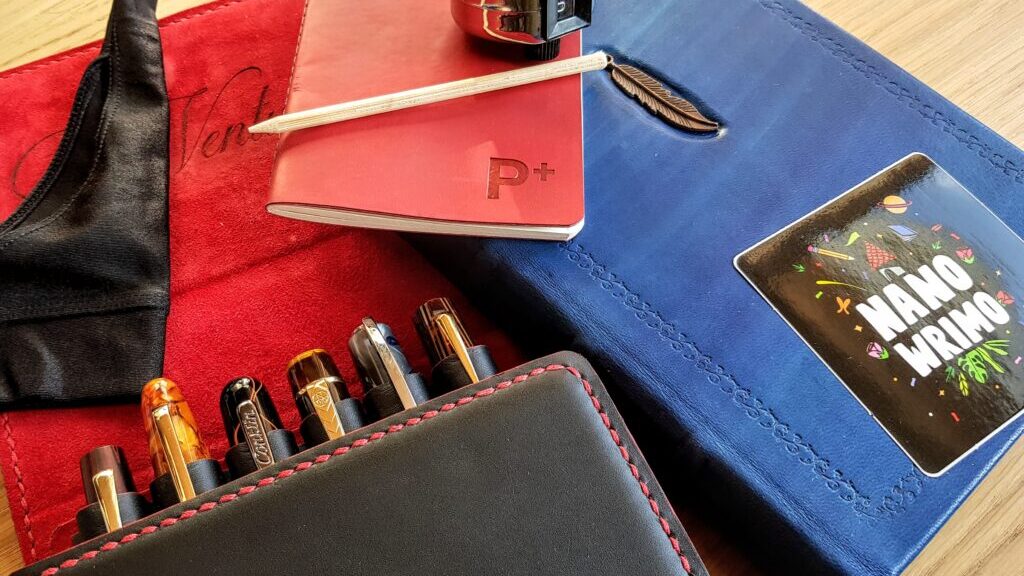
13 tips for writing NaNoWriMo by hand
This is a blog post about National Novel Writing Month. If you don’t know what that is, you might find it useful to read my post “Nibby Sunday – Write a novel in a month!” first.
This year will be my fourth time writing National Novel Writing Month by hand.
The first time was in 2016. I started the month with a trip abroad, and didn’t really have time to write much the first couple of weeks, which led to a pretty intense catching up towards the end of the month. I think I was around 20.000 words behind at one point, but in the end, I managed to get across the 50.000 word finish line just in time, on the last day of the challenge.
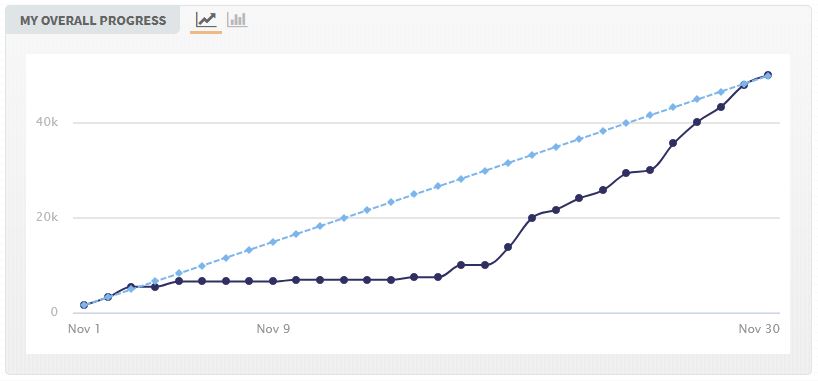
The second time was two years later, in 2018. I was determined not to fall behind this time. The second Saturday, I wrote from early morning to late night, to get a good buffer. I wrote 13.000 words in one day, and was so emptied out afterwards that I didn’t really write very much for the next couple of weeks. At the end I cruised in to a pretty comfortable 50K words, but it definitely wasn’t a consistent effort throughout the month.
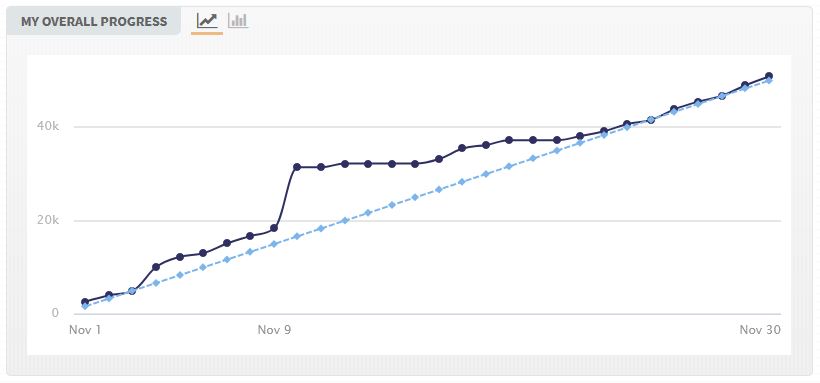
In 2020, I wrote by hand again. I had this really beautiful journal with 800 pages, and after the first few days, I realized that 50.000 words would only fill half of the book. I decided then that I would try to write 100.000 words instead, and use the whole notebook. It was a really big challenge, but this was during the pandemic, and there wasn’t really that much else going on, so I went for it. This time I was super consistent, and reached my goal on the second to last day of the month.
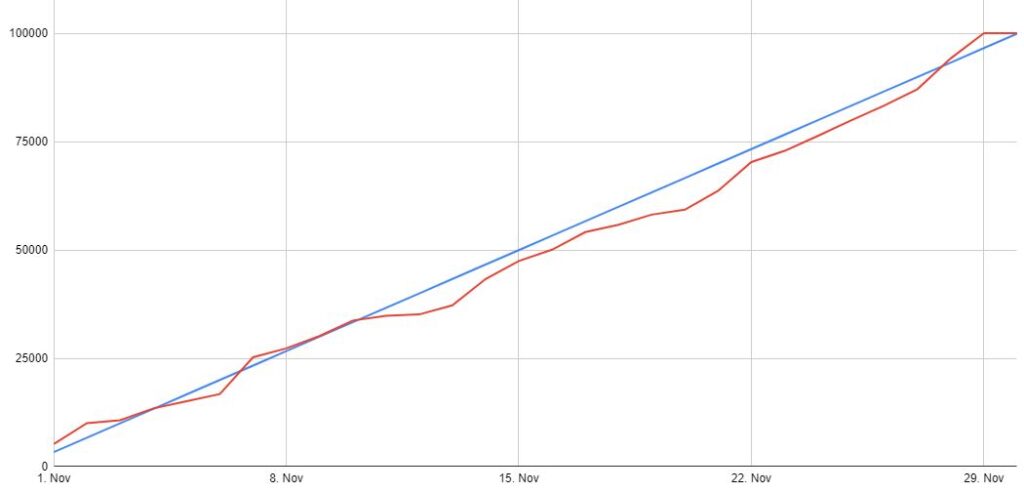
In other words, I’ve gained some experience throughout the years in doing these big writing projects by hand. I love doing NaNoWriMo with a pen and a notebook, but there’s definitely a few challenges that comes with it, and I’ll try to describe those here, and give some helpful tips for those who are considering doing NaNoWriMo the old-fashioned way.
Why on earth would you want to do this to yourself?
For most of us, writing by hand takes longer than typing on a keyboard. It can also be more tiring, and many are afraid of writing cramps if they have to write by hand for long sessions. Also, you have fewer opportunities to go back and change things you’ve already written, without having to do it all again. Going back and changing things should ideally not be done during NaNoWriMo, so that in itself is not a disadvantage, but if you have written the first draft by hand, the second draft can be more work, as you will have to write everything into your computer for further processing.
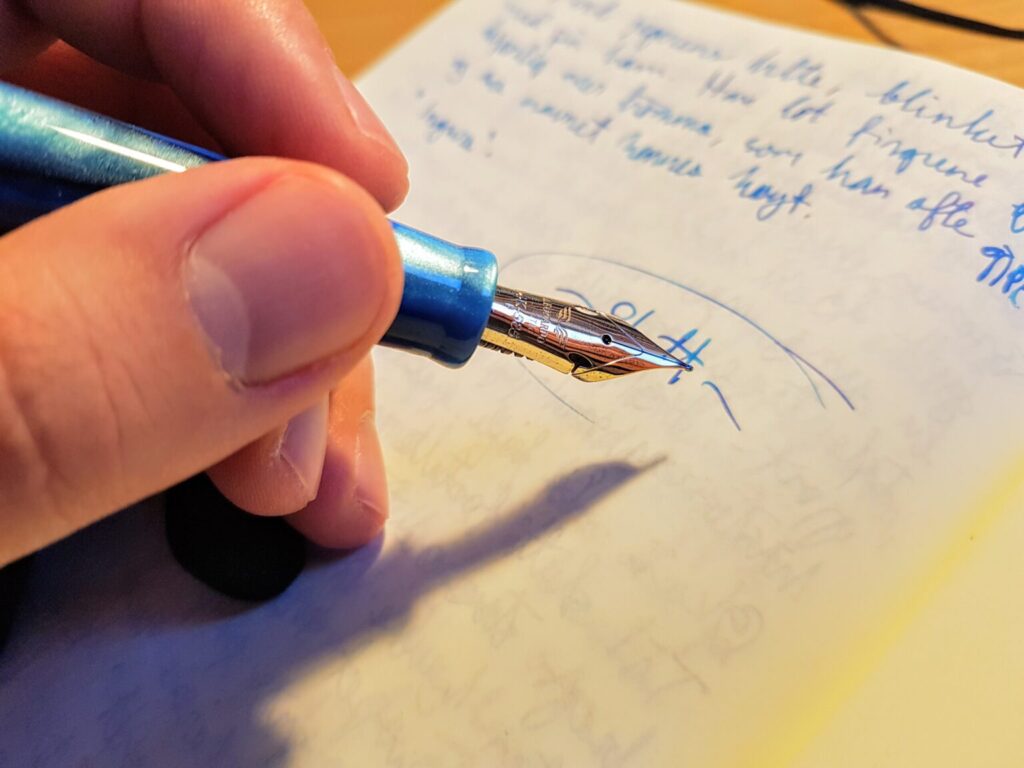
There’s a very big difference between writing on a computer and writing by hand, not just technically and equipment-wise. When I type on a keyboard, my fingers can mostly keep up with my own thoughts, but that’s much more difficult when I write by hand. Sometimes, I’ve experienced that my thoughts have been so far ahead of my pen that I’ve unconsciously skipped over whole words and sentences in the text to keep up. The trick when writing by hand is to try to slow down your mindflow as well, so that your imagination doesn’t run wild without you having time to get it down on paper. This is a matter of exercise, but it helps a lot just to be aware of it; you have to think differently when writing by hand.
There’s also an old-timey kind of charm to it. Things are moving slower. You have to slow down and take your time, and I think we can only benefit from that in a world where we are almost constantly bombarded by media impressions and information everywhere.
There are many advantages to writing by hand. You get time off from screens. You do something tangible and creative. You end up with a physical copy of your manuscript (and there are few things that beat the satisfaction of having a chock-full notebook after a month of intense writing). I also find that I am much more mobile when I only need to carry a pen and a notebook, rather than carrying a whole computer, being dependent on the battery not running out, or finding charging points etc. There’s a beautiful simplicity to just carrying a pen and a notebook. There are also far fewer distractions, compared to a computer or a tablet, where you have the entire internet to seduce you away from what you were actually planning to do.
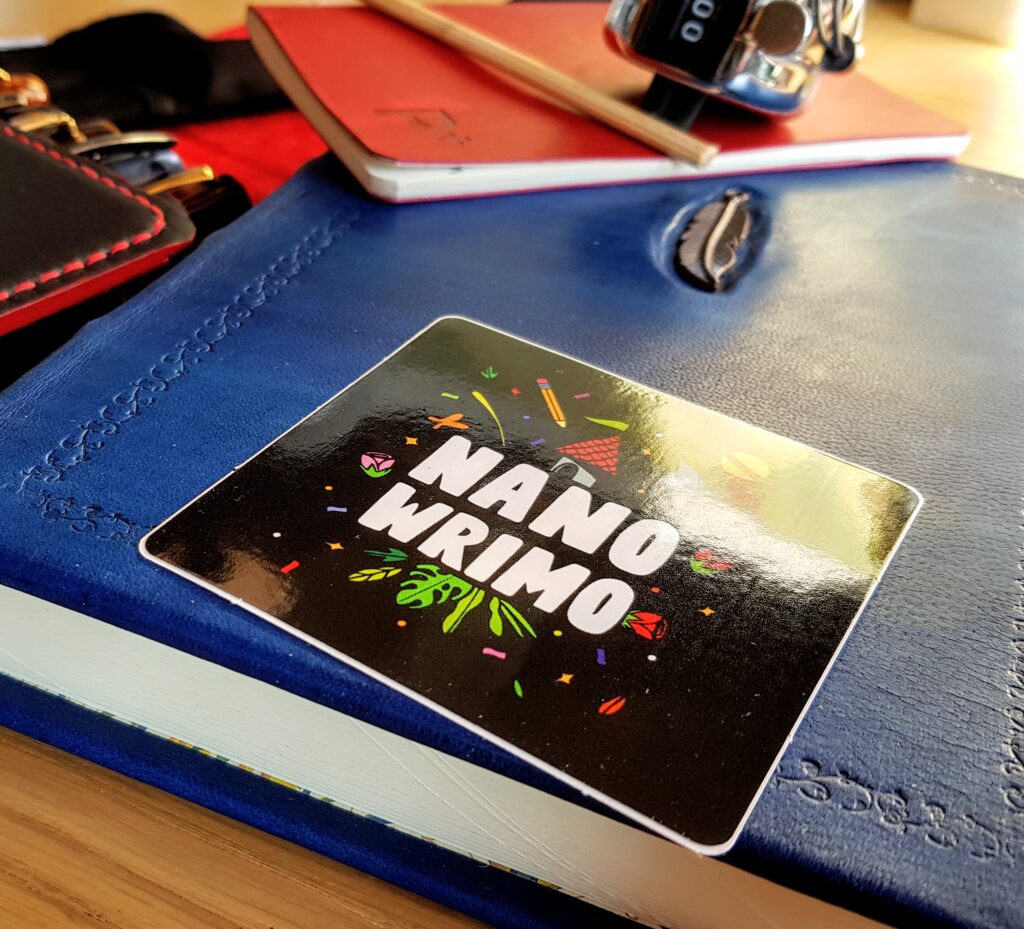
13 Tips for writing NaNoWriMo by hand
1. Use a fountain pen
With a well-adjusted fountain pen, you can write much more relaxed than with any other writing implement, as a fountain pen should be able to write just under its own weight. The only thing you need to do is prop up the pen and guide it across the paper, don’t spend your energy pressing it down, as you have to do with most other pens and pencils.
2. Choose a pen/ink you’re comfortable with
NaNoWriMo is not the right time to start experimenting with your writing equipment. Use a pen you know writes well and effortlessly, and an ink you know works well in the pen. There are few things more annoying than having your writing session ruined by poor ink flow. If you have several pens, it’s a good idea to always have a small selection with you, so that you have a backup if one runs out of ink, or otherwise can’t be used anymore. Or, for that matter, just for the variety.
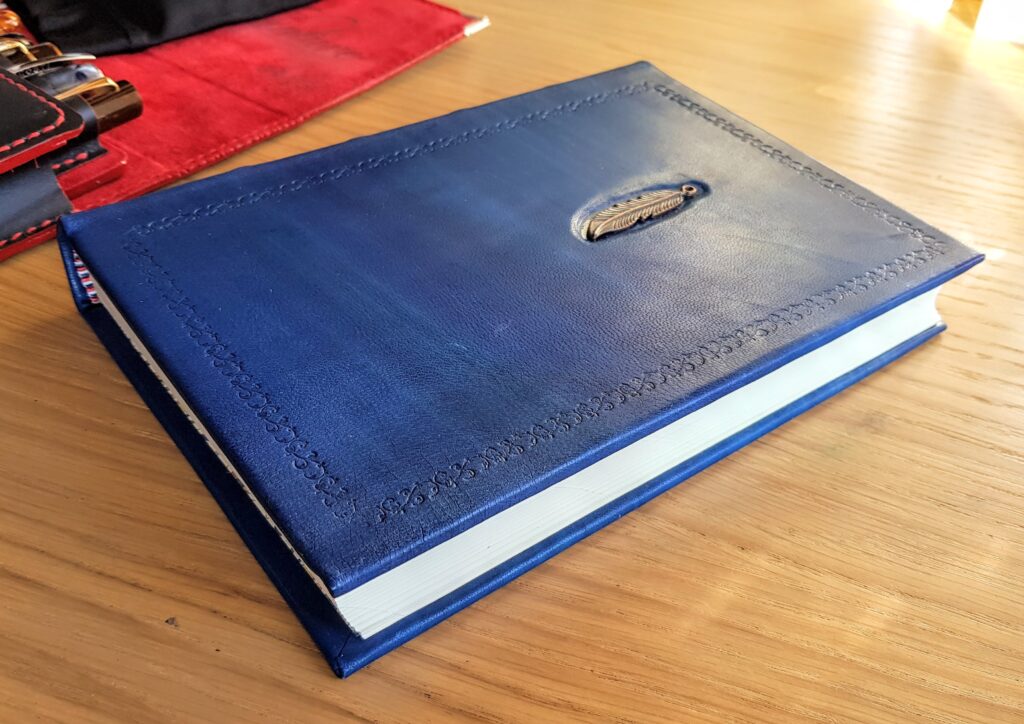
3. Be careful to choose the right notebook
The first couple of times I wrote NaNoWriMo by hand, the books I used had paper that wasn’t really optimized for fountain pens, even though the books themselves were very nice. The ink feathered and bled through the paper, and it just wasn’t a very nice writing experience. The third time, I used a Springback journal from GatzBCN. 800 pages of cream colored Tomoe River paper was absolute perfection, but at €170 this notebook isn’t exactly affordable. This year, I will be using an Everyday Notebook from Galen Leather.
Test the book you intend to use before you start, so you know the paper can handle your pens. You get your ideas down on bad paper too, but the experience is so much better when you have proper materials. Also think about whether you want a notebook with lines, dots, squares, or maybe blank pages. You’ll be spending hours upon hours with this notebook. It’s definitely worth making a little effort – and spending the dough – to find the right one.
4. Make sure you are relaxed
This is so incredibly important! Write relaxed and effortless. Don’t push against the paper, but let the pen do as much of the work as possible. Check at regular intervals that you aren’t gripping the pen harder than absolutely necessary, that your wrist is relaxed, that you’re not tensing the muscles in the rest of your arm. Make sure that you’re sitting comfortably, that you’re not bending over the table and straining your back, shoulders and neck. A good exercise can be to try to relax more and more, until the pen actually slips out of your hand. Then you know where the limit is. You can usually hold it much more loosely than you think. Take breaks every now and then and get up from your chair to shake things off a bit. It’s also nice to practice writing in a relaxed way before you start your novel on November 1. Sit down and write, pay attention to how your body feels and which muscles are tense. You can always write more relaxed than you do.
5. Write large
I don’t know if this applies to everyone, but I myself write much more relaxed if I use large letters. If you write very small, it can become strained, and you tighten your fingers around the pen to control it better when the movements are smaller. If you let go, and allow yourself a slightly larger letter size, you don’t need the same fine control over every little movement of the pen, and you can relax more.
6. Use your whole arm when you write
This is also linked to relaxation, and writing with larger movements. Then you can use the whole arm, and it relieves the small muscles in the fingers and wrist. You’ll write much more loosely and freely. Try to let your hand slide smoothly over the paper as you write, and not lift and move your elbow for each word. Find a nice flow in your handwriting. When you’ve practiced this for a while, you might find that your handwriting also looks much better.
7. Use several different pens and inks
If you have multiple fountain pens, feel free to fill them all with different inks, and vary which of them you write with. For me, it helps a lot with the motivation to change pens, if I feel that things are going a bit slow. When I continue to write with a different pen, I have a new focus.
8. Make sure you leave space for annotation
If you plan to revise your draft later, you may want to set aside space in the book for later notes. This can be done by giving yourself ample margins, or possibly only writing on one side of the sheet, so that for each page of writing you also have a blank page that can be filled with notes and revisions. I don’t do this personally, but it’s definitely worth thinking about before you’ve filled your notebook to the brink with your first draft.
9. Take your time
When you write by hand everything takes longer than with a keyboard. For it to work, you must also be able to slow down, and limit the flow of thought. I don’t know if I have any specific tips on how to achieve this, other than that you just have to be aware of it, and get used to thinking more slowly. It definitely helps to not sit in front of a screen. I also find music distracting when writing by hand, although I often prefer to listen to music when writing on a computer. This is individual, of course. Just don’t assume that the same routines work when writing by hand as when writing on a computer. It’s important to find a place and a mindset where you can calm down. Also make sure to set aside plenty of time for writing, so that you can enjoy it, and not write under stress.
10. Write every day
Make sure you write every single day, and try to build up a head start early, while you’re motivated, so you have something to go on later in the month. This is also good advice if you write on a computer, but it’s especially important when you write by hand. If you fall behind with your word count, it’s much more difficult to catch up by hand than by computer. Take it from someone who was 20K words behind at one point during NaNoWriMo 2016. It took an immense effort to be able to cross the finish line of 50.000 words before the end of the month. Try your best to write at least 1667 words every day, and preferably more on the days you can manage, so you have a buffer for the days when you don’t have time or motivation to write as much.
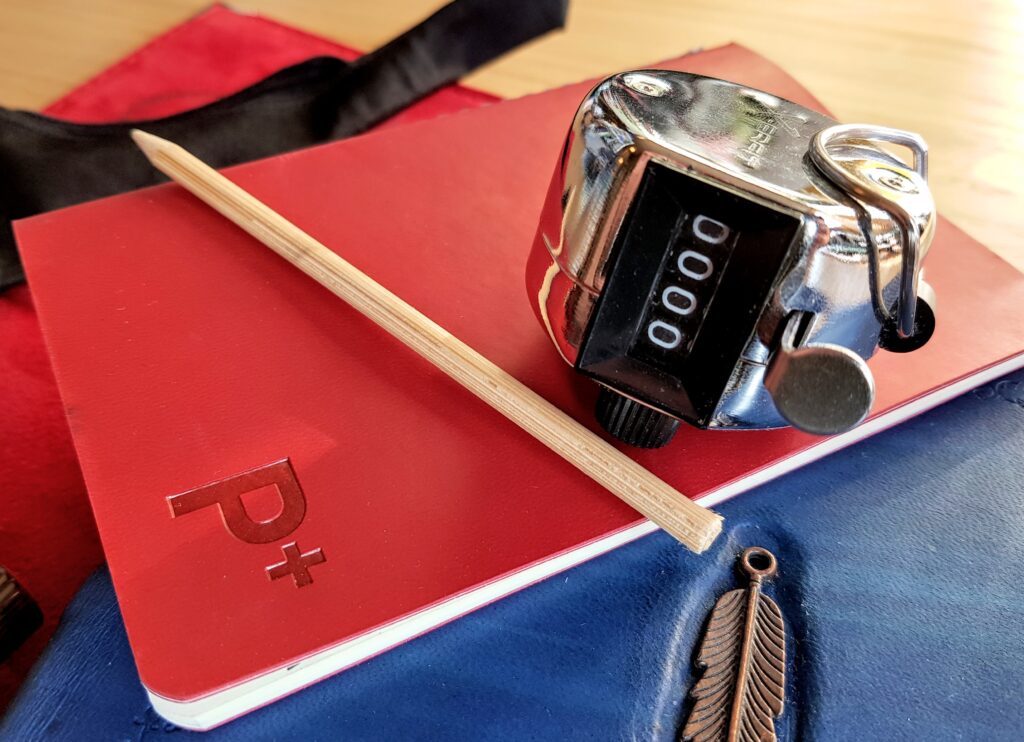
11. Use a clicker or counter app to count words
How much you’ve written is important during NaNoWriMo, and you need to keep on top of your word count. How else are you supposed to know if you’ve filled the daily word quota, or when you’ve passed 50,000 words? One thing you can do is to count the words on a number of finished pages, and calculate the average. It will give an indication of how much you’ve written in total, without actually having to count each and every word. It’s not completely accurate, though.
Personally, I like to know exactly how much I’ve written, and to do that, I have to count every word. I have often used a handheld clicker counter to count my words, but there are also mobile apps that can be used for this. I hold the counter in one hand, and a small stick in the other. Then I use the stick to lightly tap each word, while clicking the counter at the same time. That way, I can count hundreds of words without really having to concentrate. This method is also much faster than counting manually. With a little practice, you can even carry on a conversation while counting your words. Write the number of words at the bottom of each page, so you have an overview.
12. Take pictures of what you have written
When you write in a notebook, you have no backup of your novel. What do you do if the bag you keep the book in is stolen, or if the book is otherwise lost or damaged? Take a picture of every page you’ve written with your phone. That way, you have a backup. If you also synchronize your images with Dropbox, Google Drive, or some other cloud storage, you will always have access to your novel, regardless of what happens to the notebook.
13. Make use of the medium
When you write by hand, you also have the opportunity to draw, put lines, arrows, circle etc. This is much more cumbersome when you write on a computer. Take advantage of this freedom when writing by hand. Use different scripts, different colors, and play with your options when you don’t have to deal with the limitations of a writing software.
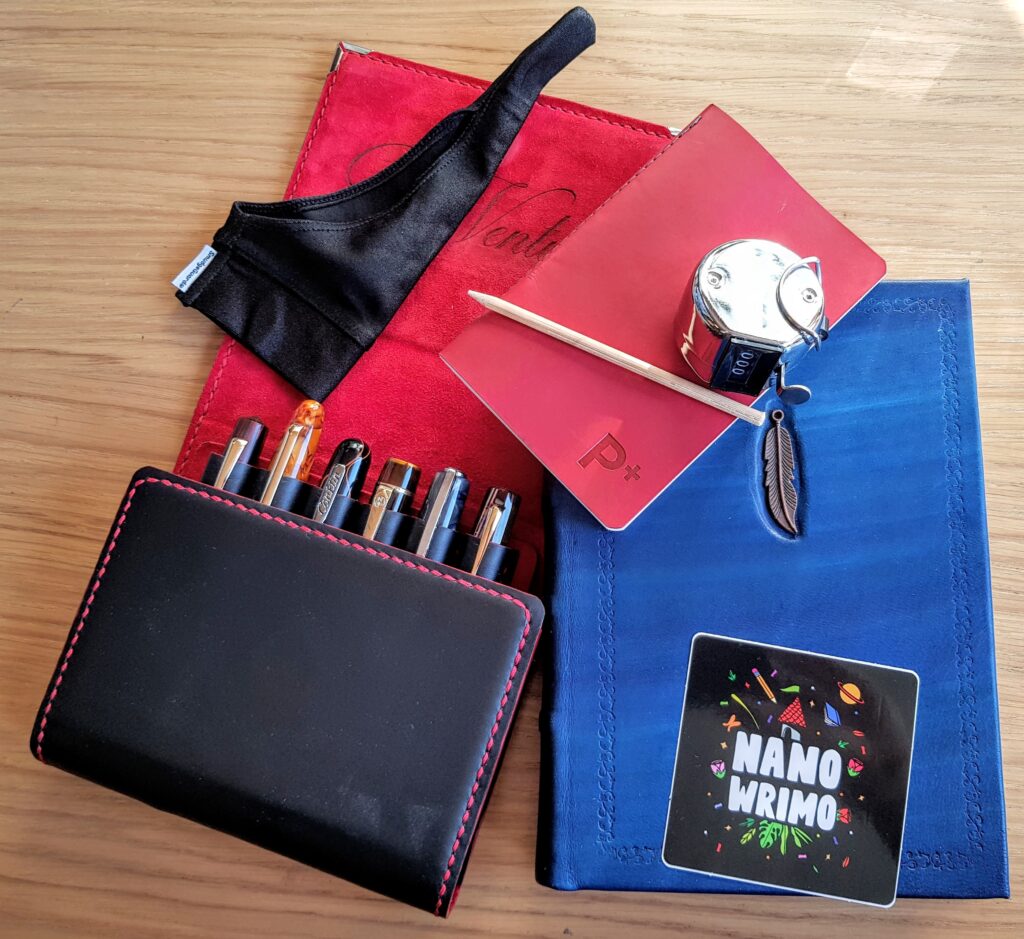
Last but not least: enjoy the writing! NaNoWriMo is an amazing opportunity to practice your handwriting, and to get some mileage on your fountain pens. For those who are skeptical about doing it by hand: give it a try! You may find that it’s not as difficult as you thought; you may even find that you absolutely love it.